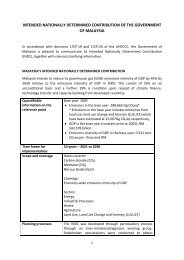RP-01638
RP-01638
RP-01638
Create successful ePaper yourself
Turn your PDF publications into a flip-book with our unique Google optimized e-Paper software.
about 50% of the cost of the existing pumps.<br />
The basic data available in the Malaysian<br />
case are shown in Table 4. Several points<br />
should be noted.<br />
Only the IDRC-University of Malaya<br />
(UM) experimental pump could be<br />
accurately assessed in terras of cost<br />
(Table 5). This is likely to appear high in<br />
view of the limited number of pumps<br />
produced and the research element<br />
involved in the design and construction.<br />
The mass-production cost of the IDRC-<br />
UM model can only be estimated at<br />
present and is based on quotations<br />
obtained from local plastic manufacturers<br />
regarding bulk orders of the different<br />
pump components. By experimenting<br />
with different manufacturing processes,<br />
it may be possible to find ways to<br />
reduce these prices.<br />
Data on other pumps (Gibson and Fuji)<br />
are obtained from the Ministry of<br />
Health records and from field interviews.<br />
The life recorded in the field for non-<br />
IDRC pumps is extremely short, ranging<br />
from 6 months to 5 years.<br />
All 12 suction pumps installed in the field<br />
in the past 2 years are still in operation.<br />
Hence, there are no figures available on<br />
the actual lifespan of these pumps. An<br />
Table 5. Major cost components ($) of experimental<br />
and production version of IDRC-UM handpump.<br />
Composent<br />
Experimental Production<br />
Piston and foot valve 59.00 8.40<br />
Spout 4,10 4.10<br />
Piston cylinder 20.20 8.70<br />
Drop pipe and pistonrod<br />
assembly 9.80 9.80<br />
Metal stand 17.40 17.40<br />
Leverage assembly 16.40 16.40<br />
Bolts and washers 6.10 8.20<br />
Total cost 133.00 73.00<br />
estimate of 7-9 years is used for the<br />
purpose of this analysis.<br />
The nonusable pumps are kept for spare<br />
parts. Thus there is no definite salvage<br />
value for the pumps. Therefore, the<br />
salvage value is assumed to be zero at the<br />
end of the economic lite of the pump.<br />
Cost data obtained from 1978 to 1981<br />
showed no significant increase in cost<br />
due to inflation. These cost figures are<br />
assumed to be in 1980 constant dollars.<br />
Water supply situation<br />
Only 43% of rural households in Malaysia<br />
are served with piped water (Table 6). However,<br />
this figure will rise to 58% by 1985 if<br />
current plans under the Fourth Malaysia Plan<br />
are implemented. In terms of the number of<br />
rural households, this means that a total of<br />
994 000 households in 1980 and 833 000<br />
households in 1985 will still have to rely on<br />
traditional sources for their daily water<br />
requirements.<br />
The Ministry of Health has, since the late<br />
1960s, supplied handpumps to a limited<br />
number of rural households. At present, a<br />
total of about 5500 wells serving about 22 000<br />
households have been constructed. This<br />
figure is, however, only about 50% of the<br />
target set in the Third Malaysia Plan. One of<br />
the main reasons for this shortfall is the<br />
difficulty in obtaining handpumps. At present,<br />
all the handpumps used by the Ministry of<br />
Health have to be imported: these include<br />
pumps such as the Dragon, Fuji, Gibson, and<br />
SGP. These pumps are relatively cheap but<br />
the experience of the Ministry is that they<br />
rarely last for more than 1 year. Also, there<br />
is a lack of spare parts whenever the pumps<br />
break down.<br />
The program under the Fourth Malaysia<br />
Plan is to increase the number of handpumps<br />
installed by 12 382 to serve about 60 000<br />
Table 6. Number ('000) and percentage of rural households served by piped water.'<br />
No. of No. served % served with<br />
rural households with piped water piped water<br />
1980 1985 1990 1980 1985 1990 1980 1985 1990<br />
Peninsular Malaysia 1485 1656 1801 698 1043 1388 47 63 77<br />
Sabah 102 159 175 18 62 106 18 39 61<br />
Sarawak 164 189 208 41 66 91 25 35 44<br />
Total 1751 2004 2184 757 1171 1585 43 58 73<br />
Source: Government of Malaysia. 1981. Fourth Malaysia Plan.<br />
'It is assumed that rural households will constitute 60% of population in 1990 as compared to 38% in 1985; and that the<br />
number of rural households that will be served with piped water for 1985-1990 will be the saure as that for 1980-1985,<br />
i.e., 414 000 households.<br />
63



